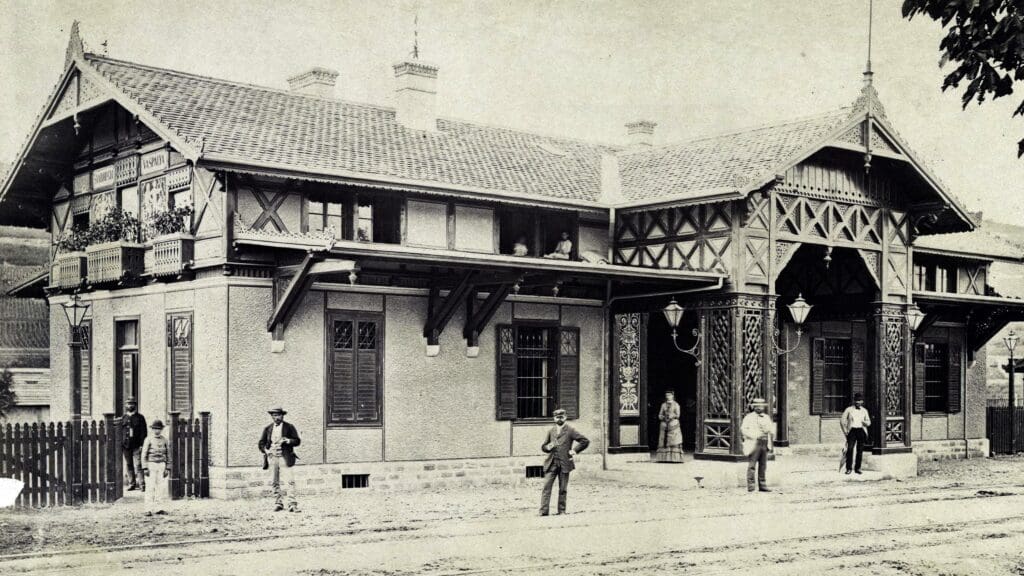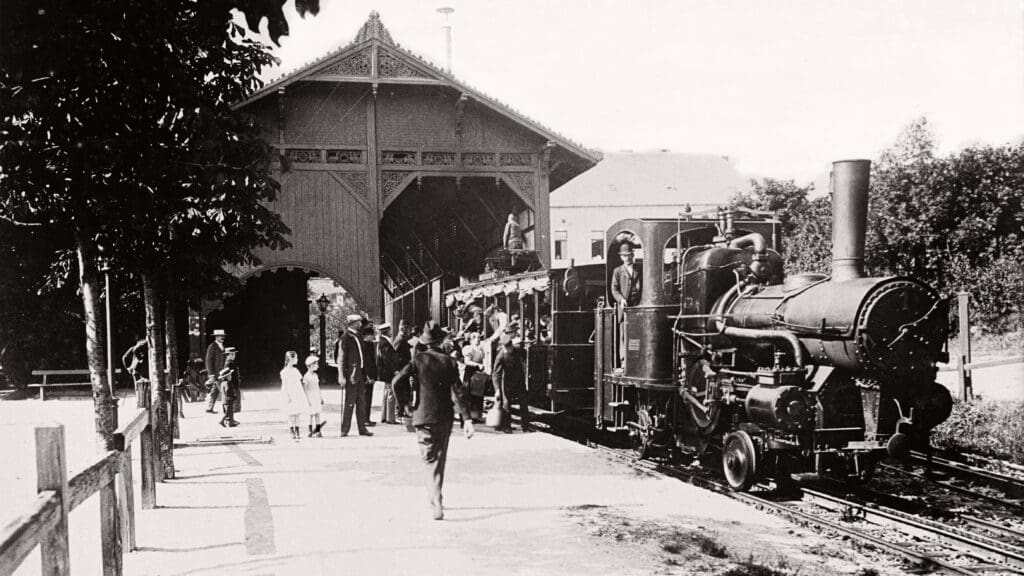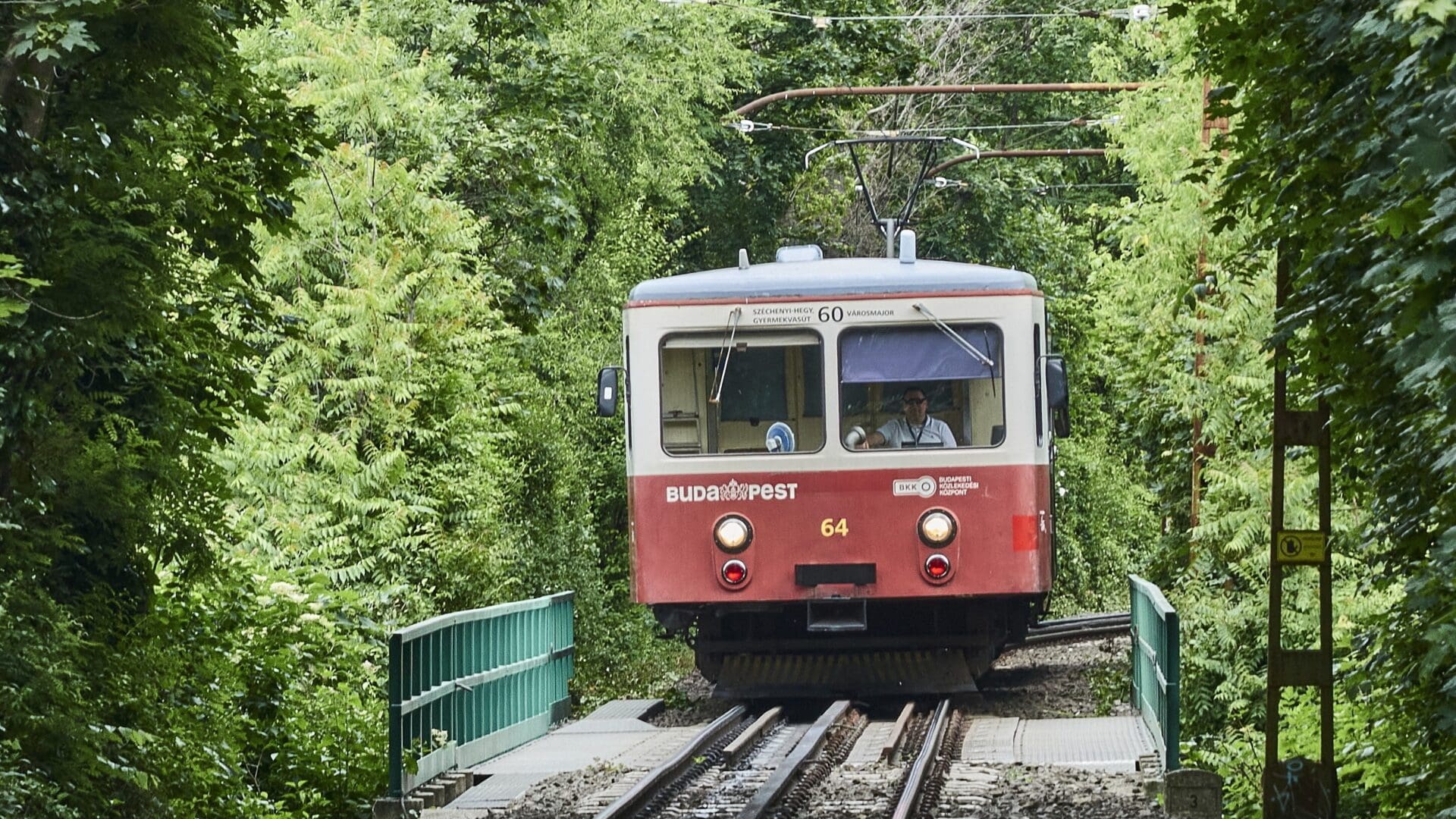The cogwheel railway, which is 149 years old today, is one of Budapest’s oldest means of public transportation. It is not only considered pioneering in domestic transportation, but also among similar mountain railways worldwide: it was the third to be completed in Europe.
Svábhegy, which was previously known for its vineyards, became one of the most beautiful and popular excursion destinations in the second half of the 19th century. Wealthy citizens of Pest-Buda and renowned artists built their holiday homes and villas in the area one after another. Soon, there was a demand to improve the transportation to the increasingly popular mountain, which was previously accessible only by horse carriage or on foot, and to integrate it into the city’s transportation system. Starting from 1868, there was already a horse-drawn railway line from Lánchíd (Chain Bridge) to Zugliget, but there was no transportation available from there to Svábhegy.
Several ideas were proposed to overcome the several hundred metres of elevation. In 1870, Ödön Széchenyi, the son of Count István Széchenyi and the initiator of the funicular in the Buda Castle, suggested the construction of an adhesion wheel mountain railway, but eventually, a newly patented solution in Europe, the cogwheel railway, was implemented.
In 1873, Ferenc Házmán, the last mayor of Buda before the unification, signed a contract with the Swiss company Internationale Gesellschaft für Bergbahnen (BGfB), which built the first two cogwheel railways in Europe. The Basel-based railway company received permission to build and operate a cogwheel railway for 40 years. This concession was later extended by 13 years.
The lower terminus of the railway was designated as ‘Ecce Homo’ Square, which is present-day Városmajor, and the upper terminus was located at an unnamed square near the current Svábhegy station. The permit also stipulated that the railway was obligated to provide transportation for passengers twice uphill and twice downhill daily only during the summer season.
Construction of the railway began on 3 July 1873, under the supervision of a Swiss engineer named Ferenc Cathry Szaléz. A standard gauge track was constructed, with a toothed rack placed in the middle of the tracks. The total length of the railway track was 2,883 metres, with an elevation of 259 metres between the two terminal stations. The travel time in both directions, uphill and downhill, was 20 minutes. Since only a single track was built on the line, a railway siding had to be incorporated to allow trains travelling in opposite directions to pass each other. This was achieved by using push-off switches. Their inclusion allowed for the later adoption of a 30-minute frequency of service.
At the lower terminus of the railway in Városmajor, a two-story, timber-framed impressive station building was erected following the Swiss model. The facade of the building, adorned with frescoes and woodcarvings, greeted visitors with the motto of the cogwheel railway: Per Ardua Ad Astra (Through Adversity to the Stars).
Similarly, at the upper terminus of the cogwheel railway, a multi-story, timber-framed station building was erected. To operate the cogwheel railway, three steam locomotives with 120 horsepower were obtained from Winterthur, Switzerland, and ten green open passenger cars, as well as three uncovered freight cars, were purchased from the Hernalser Waggonfabrik factory near Vienna. (An additional locomotive and two passenger cars were acquired the following year.) The timber-framed passenger cars had nine separate rows of seats with six seats each. On top of the cars, there were brake operators who had a good view of the entire track from above. One of the original timber-framed passenger cars has been preserved, which was restored for the 125th anniversary of the cogwheel railway’s establishment. This car is currently in operation as part of the nostalgic rides of BKV Zrt. (Budapest Transport Company).

The cogwheel railway was completed in less than a year.
The official inauguration took place on 24 June 24, 1874, and regular service started the next day.
Originally, the railway was intended for tourist purposes, so it operated only during the summer season in the decades following its inception, specifically between 15 April and 15 October.
In addition to passenger transportation, the cogwheel railway also handled freight traffic. Construction materials were often transported for the gradually developing area, and the local establishments were also supplied with goods through the railway. A peculiar feature was that loaded horse-drawn carriages were carried on the freight cars with the horses and their cargo. Freight traffic was discontinued after World War II.
To increase traffic, plans were already made in the late 1880s to extend the railway. The ideas of a branch line reaching Normafa and an extension to Széchenyi Hill also emerged, but ultimately only the latter was accepted in 1889, and the new 850-metre section opened on 15 May 1890, making the total length of the railway over 3.7 km, with an elevation of 327 metres.
In 1895, due to the dissolution of the Swiss maintenance firm, the cogwheel railway came under the ownership of the Svábhegy Cogwheel Railway Company. In 1910, winter operations were introduced by popular demand. Some cars were modified accordingly, with the addition of windows and heating.
The cogwheel railway, now operating during the winter as well, was highly useful for winter sports enthusiasts in addition to regular passenger service. Hundreds of people wanting to go sledding and skiing could reach Svábhegy and the top of Széchenyi Hill by train. A separate carriage for transporting skis was built. However, this single vehicle proved to be not enough, so the height of the passenger cars was also increased.

Throughout its history, due to operating at a loss, the discontinuation of the cogwheel railway was raised multiple times. Many hoped that electrification would save the railway. As electrification was not possible for a long time, interesting experiments were conducted to make the operation more cost-effective. A gasoline-powered cogwheel railbus was ordered from the Kelenföld BSzKRt Workshop, which could only accommodate 16 passengers. However, this experiment did not provide a lasting solution to the unprofitable operation.
Starting November 1918, the cogwheel railway came under the management of the Budapest Electric City Trains Company, and from September 1926, the BSzKRt took over the operation. The BSzKRt initiated the modernisation of the railway and prepared the groundwork for electrification. A new power substation was built, and two additional sidings were installed, resulting in an average increase of 15 minutes in train frequency. During this time, the depot and workshop were also constructed at the lower terminus of the railway in Városmajor.
The electrification of the railway was completed 94 years ago, in 1929, and
on 2 July, the world’s first electrified cogwheel railway began operation.
To transition to electric operation, the BSzKRt ordered eight Rowan-system trains consisting of locomotives and trailers from Ganz. The steam-powered railway’s passenger cars were also modified, allowing them to remain in service as trailers attached to the new trains. The electrified vehicles were painted yellow, and the old cars were also repainted accordingly. These vehicles remained in use until 1973.
During World War II, the cogwheel railway suffered significant damage. The station building in Városmajor was also destroyed. After the shutdown in December 1944, regular operations resumed only in June 1945. In 1948, the cogwheel railway received an unusual task of transporting vehicles for the construction of the Pioneer Railway to Széchenyi Hill. During the following period, due to the unprofitable operation, the closing down of the cogwheel railway was once again considered. Some opinions were raised suggesting that the cogwheel railway be replaced by buses or trolleybus routes. (From 1953, the number 21 bus was already providing transportation to the Svábhegy.)
In 1968, the cogwheel railway came under the operation of the newly established BKV (Budapest Transport Company) on 1 January. The idea of discontinuation was ultimately rejected in 1973. As Budapest was preparing to celebrate the 100th anniversary of its unification, the city took a stance in favour of preserving and renovating the cogwheel railway. The relevance of the renovation was not only influenced by the centenary, but also by the approaching 100th birthday of the cogwheel railway itself. This renovation not only involved the renewal of the railway line, but also the construction of new station buildings and waiting areas, as well as the replacement of the rolling stock. The operating voltage was increased from the previous 600 volts to 1500 volts, with travel time being reduced to 19 minutes downhill and 18 minutes uphill. The previously used vehicles, including the trailers that had been in service for 99 years since the steam traction era, were withdrawn from operation. The red and white trains consisting of one motor car and one control trailer, which are still in service today, were procured from the Austrian company Simmering Graz Pauker (SGP).
In the 1990s, several renovations and modernisations were carried out on the cogwheel railway. Currently, trains run every 20 minutes on weekdays and every 12-15 minutes at weekends.
Related articles:








